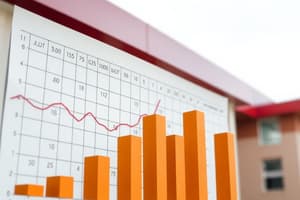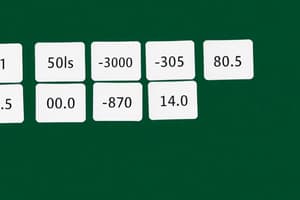Podcast
Questions and Answers
What type of dependent variable is analyzed in qualitative models?
What type of dependent variable is analyzed in qualitative models?
- Variables expressing alternatives (correct)
- Binary economic indicators
- Details of observable income levels
- Continuous variables that are fully observable
In the context of binary choice models, what does P(𝑦𝑖 = 0|𝑥𝑖) represent?
In the context of binary choice models, what does P(𝑦𝑖 = 0|𝑥𝑖) represent?
- The expected output given the independent variables
- The likelihood of multiple outcomes occurring
- The complementary probability for the event not happening (correct)
- The probability of the dependent variable being equal to one
Which example best illustrates a binary choice model?
Which example best illustrates a binary choice model?
- Studying the reasons behind voting patterns for a bill (correct)
- Analyzing the amount of money individuals spend
- Evaluating the total number of jobs available in an economy
- Calculating the average income of college graduates
What does the function $f(𝑦𝑖 |𝑥𝑖)$ represent in binary choice models?
What does the function $f(𝑦𝑖 |𝑥𝑖)$ represent in binary choice models?
What is a primary characteristic of limited dependent variable models?
What is a primary characteristic of limited dependent variable models?
In the binary choice model, what is the significance of $p(𝑥𝑖)$?
In the binary choice model, what is the significance of $p(𝑥𝑖)$?
Which model would best explain why some individuals choose to moonlight?
Which model would best explain why some individuals choose to moonlight?
In what way are qualitative models applied in econometrics?
In what way are qualitative models applied in econometrics?
What does the equation $\beta_0 + \sum_{j=1}^{k} \beta_j x_{ij} = 1$ imply about $y_i$?
What does the equation $\beta_0 + \sum_{j=1}^{k} \beta_j x_{ij} = 1$ imply about $y_i$?
In the context of the random error $e_i$, what happens when $y_i = 0$?
In the context of the random error $e_i$, what happens when $y_i = 0$?
What characteristic does the conditional variance of the random error $e_i$ have in this model?
What characteristic does the conditional variance of the random error $e_i$ have in this model?
What transformation is needed for $p(x_i)$ in order to ensure it lies within the interval [0,1]?
What transformation is needed for $p(x_i)$ in order to ensure it lies within the interval [0,1]?
How is the probit model structured according to the content provided?
How is the probit model structured according to the content provided?
What is the interpretation of $\frac{\partial P_i}{\partial x_{ij}}$ in the probit model?
What is the interpretation of $\frac{\partial P_i}{\partial x_{ij}}$ in the probit model?
Which underlying distribution is utilized for the logit model comparison?
Which underlying distribution is utilized for the logit model comparison?
What does $F(\cdot)$ represent in the context of the probit model?
What does $F(\cdot)$ represent in the context of the probit model?
What does the immediate impact multiplier 𝛽₀ represent in the context of the relationship between variables X and Y?
What does the immediate impact multiplier 𝛽₀ represent in the context of the relationship between variables X and Y?
Which assumption indicates that the variables used in the models do not change over time?
Which assumption indicates that the variables used in the models do not change over time?
In a Distributed Lag Model, what does the variable 𝜖ₜ represent?
In a Distributed Lag Model, what does the variable 𝜖ₜ represent?
What condition is described by having Cov(𝜖ₜ, 𝜖ₛ) = 0 for t ≠ s?
What condition is described by having Cov(𝜖ₜ, 𝜖ₛ) = 0 for t ≠ s?
What does the cumulative effect of changes in X on Y over multiple periods represent?
What does the cumulative effect of changes in X on Y over multiple periods represent?
Which of the following is one of the uses of the Distributed Lag Model?
Which of the following is one of the uses of the Distributed Lag Model?
In relation to the error terms, what does the assumption of homoscedasticity signify?
In relation to the error terms, what does the assumption of homoscedasticity signify?
What can be inferred if both Yₜ and Xₜ are stationary random variables?
What can be inferred if both Yₜ and Xₜ are stationary random variables?
What is the primary purpose of the Multinomial Logit Model?
What is the primary purpose of the Multinomial Logit Model?
How many equations are required when using dummy variables for categorical variables with m categories?
How many equations are required when using dummy variables for categorical variables with m categories?
What does the first factor in the McDonald-Moffit decomposition represent?
What does the first factor in the McDonald-Moffit decomposition represent?
In the context of the ordered logit model, what does 𝝅𝑤 represent?
In the context of the ordered logit model, what does 𝝅𝑤 represent?
Which statement is true regarding time-series data?
Which statement is true regarding time-series data?
When calculating the probability of an event not happening in a multinomial logit model, what is the equation used?
When calculating the probability of an event not happening in a multinomial logit model, what is the equation used?
In a distributed lag model, what do the parameters $\beta_a$ represent?
In a distributed lag model, what do the parameters $\beta_a$ represent?
In the Multinomial Logit Model, how is the reference category typically selected?
In the Multinomial Logit Model, how is the reference category typically selected?
What characteristic distinguishes a finite distributed lag model?
What characteristic distinguishes a finite distributed lag model?
What type of categories does the Ordered Logit Model deal with?
What type of categories does the Ordered Logit Model deal with?
In the computation of probabilities for ordered logit, which formula relates to the probability of being in category 0?
In the computation of probabilities for ordered logit, which formula relates to the probability of being in category 0?
Why is confounding possible when shuffling time-series data?
Why is confounding possible when shuffling time-series data?
What does the term e^(Z - 𝜅𝑤) signify in the context of ordered logit model?
What does the term e^(Z - 𝜅𝑤) signify in the context of ordered logit model?
What does the notation $Cov(Y_{t-k}, X_t)=0$ imply in the context of a distributed lag model?
What does the notation $Cov(Y_{t-k}, X_t)=0$ imply in the context of a distributed lag model?
How are changes accounted for in the McDonald-Moffit decomposition?
How are changes accounted for in the McDonald-Moffit decomposition?
Which statement accurately describes ordered categories analyzed by the Ordered Logit Model?
Which statement accurately describes ordered categories analyzed by the Ordered Logit Model?
What is one of the natural order features of time-series data?
What is one of the natural order features of time-series data?
What is a key feature of the Multinomial Logit Model when compared to the Ordered Logit Model?
What is a key feature of the Multinomial Logit Model when compared to the Ordered Logit Model?
Which of the following is NOT a factor typically considered in a consumer's choice when selecting a product?
Which of the following is NOT a factor typically considered in a consumer's choice when selecting a product?
When faced with multiple alternatives, what aspect does marketing research relate most closely to?
When faced with multiple alternatives, what aspect does marketing research relate most closely to?
If a consumer has four product options, what signifies a 'reference category' in multinomial models?
If a consumer has four product options, what signifies a 'reference category' in multinomial models?
Flashcards are hidden until you start studying
Study Notes
Qualitative and Limited Dependent Variable Models
- Qualitative models have dependent variables represented as alternatives, like 0 or 1.
- Limited models have continuous dependent variables but their values aren't entirely observable.
- Examples of economic applications include:
- Explaining why individuals take second or third jobs, known as "moonlighting".
- Predicting legislative voting patterns.
- Analyzing loan application acceptance rates at a bank.
- Identifying factors in school board elections.
- Determining what influences female college students to study engineering.
Binary Choice Models
- The probability of the event occurring, represented by 𝑃(𝑦𝑖 = 1|𝑥𝑖 ), is also denoted as 𝑝(𝑥𝑖 ).
- The probability of the event not occurring, 𝑃(𝑦𝑖 = 0|𝑥𝑖 ), is 1 − p(𝑥𝑖 ).
- This can be expressed using the conditional probability function: 𝑓(𝑦𝑖 |𝑥𝑖 ) = p(𝑥𝑖 )𝑦𝑖 (1 − p(𝑥𝑖 ))1−𝑦𝑖 where 𝑦𝑖 = 0,1.
Transportation Economics Case
- Transportation economics models can be used to analyze individual decisions regarding driving versus commuting.
- The decision of whether to drive (𝑦𝑖 = 1) or not (𝑦𝑖 = 0) is based on a sum of factors represented by 𝛽0 + ∑𝑘𝑗=1 𝛽𝑗 𝑥𝑖𝑗.
- If 𝑦𝑖 = 1, then 𝛽0 + ∑𝑘𝑗=1 𝛽𝑗 𝑥𝑖𝑗 = 1, and if 𝑦𝑖 = 0, then 𝛽0 + ∑𝑘𝑗=1 𝛽𝑗 𝑥𝑖𝑗 = 0.
- The random error 𝑒𝑖 has two possible values: −E(𝑦𝑖 |𝑥𝑖 ) or 1 − E(𝑦𝑖 |𝑥𝑖 ).
Probit Model
- The probit model uses the cumulative normal function to approximate p(𝑥𝑖 ).
- It relies on the standard normal distribution with a mean of 0 and variance of 1.
- The marginal effect of a variable 𝑥𝑖𝑗 in a probit model is given by: 𝜕𝑃𝑖 / 𝜕𝑥𝑖𝑗 = 𝛽𝑗 ∙ F(𝑍𝑖 ), where F(𝑍𝑖 ) is the cumulative probability computed at the means of 𝑥𝑖𝑗.
Multinomial Logit Model
- Multinomial logit is used when the dependent variable has more than two categories.
- The model considers an index, 𝑌 ∗, with values 0, 1, 2, 3, ...
- To calculate probabilities for unordered categories, a reference category is chosen (usually the most frequent).
- For ordered categories (ordered logit model), dummy variables are used, and threshold values (cut-off points) are introduced.
- The marginal effect can be decomposed using the McDonald-Moffit decomposition, which considers the effect for both the observed and unobserved categories.
Time-Series Data
- Time-series data is collected over time on one particular economic unit, such as individuals, households, firms, or countries.
- Two key characteristics of time-series data are the correlation of observations by past values and a natural order based on time.
Distributed Lag Model DL(q)
- The distributed lag model represents the influence of current and past values of an independent variable (𝑥) on a dependent variable (𝑦).
- The model includes lagged variables up to a certain period (𝑞).
- Assumptions:
- No feedback effects: Cov(𝑌𝑡−𝑘 , 𝑋𝑡 )= 0 for all 𝑘 > 0. Changes in 𝑌 do not influence 𝑋 in the future.
- Normality of error terms: ∈𝑡 ~𝑁(0, 𝜎 2 ), with zero mean and homoscedasticity.
- No autocorrelation in the residuals: Cov 𝜖𝑡 , 𝜖𝑠 ) = 0 𝑡 ≠ 𝑠.
- Stationarity is assumed: mean, variance, and autocovariance are constant over time.
Possible Uses of Distributed Lag Model
- Forecasting, for example, using past interest rates to predict future inflation.
- Policy analysis, such as assessing how inflation will react to changes in interest rates.
Studying That Suits You
Use AI to generate personalized quizzes and flashcards to suit your learning preferences.



